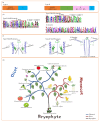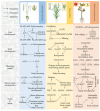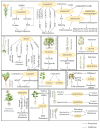Evolution and Function of MADS-Box Transcription Factors in Plants
- PMID: 39769043
- PMCID: PMC11676252
- DOI: 10.3390/ijms252413278
Evolution and Function of MADS-Box Transcription Factors in Plants
Abstract
The MADS-box transcription factor (TF) gene family is pivotal in various aspects of plant biology, particularly in growth, development, and environmental adaptation. It comprises Type I and Type II categories, with the MIKC-type subgroups playing a crucial role in regulating genes essential for both the vegetative and reproductive stages of plant life. Notably, MADS-box proteins can influence processes such as flowering, fruit ripening, and stress tolerance. Here, we provide a comprehensive overview of the structural features, evolutionary lineage, multifaceted functions, and the role of MADS-box TFs in responding to biotic and abiotic stresses. We particularly emphasize their implications for crop enhancement, especially in light of recent advances in understanding the impact on sugarcane (Saccharum spp.), a vital tropical crop. By consolidating cutting-edge findings, we highlight potential avenues for expanding our knowledge base and enhancing the genetic traits of sugarcane through functional genomics and advanced breeding techniques. This review underscores the significance of MADS-box TFs in achieving improved yields and stress resilience in agricultural contexts, positioning them as promising targets for future research in crop science.
Keywords: MADS-box; crop improvement; evolution and function; stress response.
Conflict of interest statement
The authors declare no conflicts of interest.
Figures



Similar articles
-
Characteristics of banana B genome MADS-box family demonstrate their roles in fruit development, ripening, and stress.Sci Rep. 2020 Nov 30;10(1):20840. doi: 10.1038/s41598-020-77870-w. Sci Rep. 2020. PMID: 33257717 Free PMC article.
-
Genome-wide characterization and expression profiling of MADS-box family genes during organ development and drought stress in Camelina sativa L.Sci Rep. 2025 Mar 18;15(1):9327. doi: 10.1038/s41598-025-93724-9. Sci Rep. 2025. PMID: 40102605 Free PMC article.
-
Expression profiling of MADS-box gene family revealed its role in vegetative development and stem ripening in S. spontaneum.Sci Rep. 2020 Nov 25;10(1):20536. doi: 10.1038/s41598-020-77375-6. Sci Rep. 2020. PMID: 33239664 Free PMC article.
-
MADS-box genes and crop domestication: the jack of all traits.J Exp Bot. 2018 Mar 24;69(7):1447-1469. doi: 10.1093/jxb/erx479. J Exp Bot. 2018. PMID: 29474735 Review.
-
Make hay when the sun shines: the role of MADS-box genes in temperature-dependant seasonal flowering responses.Plant Sci. 2011 Mar;180(3):447-53. doi: 10.1016/j.plantsci.2010.12.001. Epub 2010 Dec 14. Plant Sci. 2011. PMID: 21421391 Review.
Cited by
-
QTL-Seq and Fine-Mapping Analyses Identify QTL and Candidate Genes Controlling Snake-like Pod Surface Trait in Vegetable Cowpea Yardlong Bean.Plants (Basel). 2025 May 12;14(10):1447. doi: 10.3390/plants14101447. Plants (Basel). 2025. PMID: 40431012 Free PMC article.
-
Genome-Wide Identification and Expression Analyses of the MADS-Box Gene During Flowering in Primulina huaijiensis.Plants (Basel). 2025 Jun 16;14(12):1843. doi: 10.3390/plants14121843. Plants (Basel). 2025. PMID: 40573831 Free PMC article.
-
Functional divergence of LncRNAs in wheat-fungal interactions: insights from stem rust-responsive wheat transcriptomes.Physiol Mol Biol Plants. 2025 May;31(5):709-727. doi: 10.1007/s12298-025-01599-x. Epub 2025 May 15. Physiol Mol Biol Plants. 2025. PMID: 40568480
References
-
- Kaufmann K., Muiño J.M., Jauregui R., Airoldi C.A., Smaczniak C., Krajewski P., Angenent G.C. Target genes of the MADS transcription factor SEPALLATA3: Integration of developmental and hormonal pathways in the Arabidopsis flower. PLoS Biol. 2009;7:e1000090. doi: 10.1371/journal.pbio.1000090. - DOI - PMC - PubMed
Publication types
MeSH terms
Substances
Grants and funding
- CATASCXTD202402/Chinese Academy of Tropical Agricultural Sciences for Science and Technology Innovation Team of National Tropical Agricultural Science Center
- 32301873 and 32460497/National Natural Science Foundation of China
- 2022YFD2301100/National Key Research and Development Program of China
- NKLTCB-YAAS-2024-S01, Yunnan/Project of National Key Laboratory for Tropical Crop Breeding
- CARS-17/China Agriculture Research System of MOF and MARA
LinkOut - more resources
Full Text Sources
Miscellaneous

